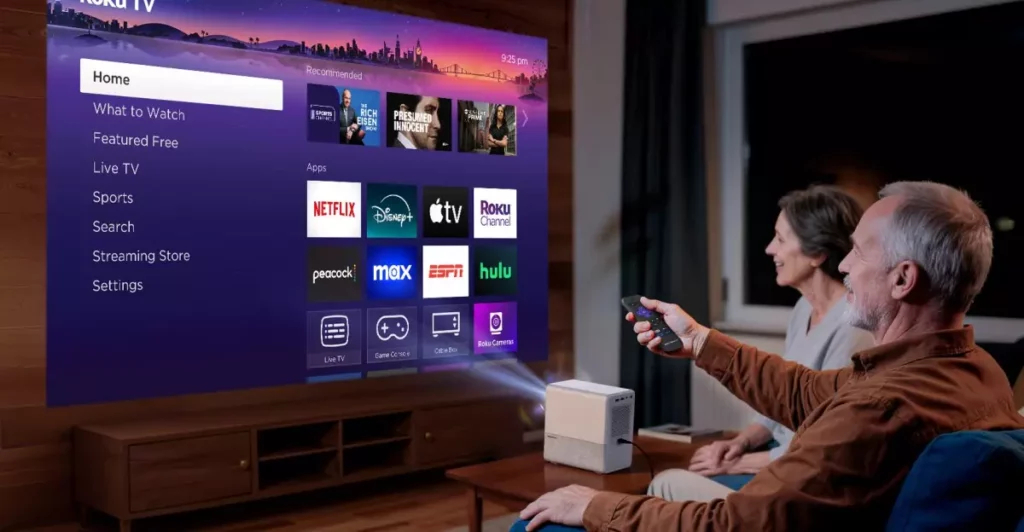In an era where entertainment is increasingly mobile, the Aurzen D1R Cube emerges as a bold attempt to redefine the portable projector landscape. Priced at an astonishingly affordable $170, it promises more than just portability—it claims to deliver a full-fledged streaming experience directly from a compact device. While such a proposition sounds promising on paper, a deeper critique reveals that this device might be more of a dazzling concept than a practical solution for genuine entertainment needs.
The core appeal here lies in convenience. The D1R Cube’s built-in Roku TV OS negates the need for external streaming sticks or dongles—an age-old pain point for device overload and clutter. Its integration of Netflix, Disney Plus, Amazon Prime, and a vast array of free channels makes it an all-in-one entertainment hub that’s surprisingly accessible for its price point. This all-in-one approach could democratize access to streaming content—especially for those who are less tech-savvy or seeking simplicity.
However, beneath the surface, critical limitations quickly surface. Most glaringly, the projector’s brightness of 330 ANSI lumens is starkly inadequate for vibrant, crisp images in anything but a very dark environment. Expect washed-out visuals, especially when projecting larger images up to 150 inches—an ambitious size, but one that demands serious lumen output to be worthwhile. The comparison to Anker’s Nebula X1 Pro with 3,500 lumens highlights the magnitude of this gap. While the D1R Cube claims support for 4K content, it relegates it to a 1080p display—a curious omission that raises questions about its actual fidelity and whether it’s more of a marketing rip than a visual upgrade.
Despite these quality shortcomings, Aurzen’s inclusion of features like automatic focus, keystone correction, and wireless connectivity points to a manufacturer that understands the importance of usability and convenience. They have prioritized user-friendly setups, which are essential for casual or on-the-go movie nights. Yet, this raises the question: are these features enough to compensate for the device’s limitations? For truly immersive entertainment, you need more than just ease of setup.
From a content perspective, the decision to employ Roku TV OS is a tradeoff. Roku’s platform offers a straightforward, subscription-free access to myriad FAST channels, live feeds, and a selection of popular apps. Yet, this simplicity comes at a cost—the platform’s smaller app ecosystem compared to Google TV. Notably, many entry-level projectors running Google’s OS require external devices to stream Netflix, which diminishes the appeal of an all-in-one projector. Roku’s choice to include native access to top-tier streaming services is a strategic move; it caters to the mass market seeking hassle-free streaming without extra gadgets.
The question remains: in a market flooded with more luminous, technically capable projectors—such as the tech-packed Nebula X1 Pro—can the D1R Cube carve out a meaningful niche? The answer today leans towards skepticism. While it’s compelling as a portable device for outdoor movie nights or quick presentations, it falls short as a serious home entertainment centerpiece. Its low brightness and limited resolution, despite being supporting 4K content, undermine its potential as a high-quality display device.
In essence, the Aurzen D1R Cube embodies a paradox: it’s an impressive feat of affordability and convenience that risks being overshadowed by its technical shortcomings. It appeals to a very specific consumer—those who prioritize portability and simplicity over image quality and performance. While the device may shake up the portable projector market, it also exemplifies a broader trend of tech companies offering ‘good enough’ solutions at disruptive prices. Yet, for those of us with slightly higher standards for clarity, brightness, and durability, the Cube remains more of a novelty than a revolution. It’s a reminder that in the pursuit of affordability, certain sacrifices—like lumens and resolution—may ultimately diminish the user experience, rendering the device more suitable for casual on-the-go use rather than serious home entertainment.









Leave a Reply